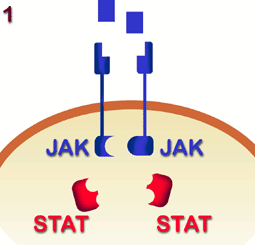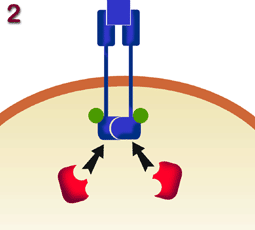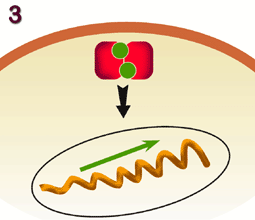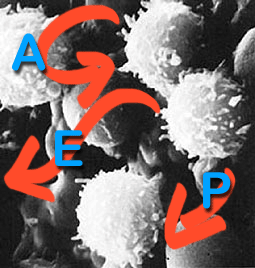| Chapter 6. The cytokines. | | | | | | Cytokines are a group of proteins secreted by different cells, mainly of the immune system, either as a response to an immune stimulus or as an intercellular signal after the stimulation of one of these cells. Cytokines have a wide variety of functions and are of key importance in the immune response, both natural or innate and adaptive. | | | | | CYTOKINES CAN ACT AS: | | 1. Mediators of the innate immune response (inflammation, chemotaxis, macrophage activation, NK cells) and adaptive immune response (humoral and cell). | | 2. Regulators of lymphocyte activation, proliferation and differentiation. | | 3. Stimulators of the growth of hematopoietic stem cells. | | All proteins have been grouped under the generic name of cytokines generally glycosylated and of low molecular weight, secreted by the cells of the immune system, principally monocytes and T lymphocytes. Other non-immune cells also produce cytokines, such as endothelial cells and fibroblasts. Formerly, cytokines were named according to the origin of the secretor cell. They were defined as: cytokines (produced by lymphocytes) monokines (monocytes) or depending on their activity: chemokines, interleukins, interferons. | | CYTOKINE RECEPTORS. ACTIVATION MECHANISMS  1Binding of the cytokine to the receptor.  2.- Dimerization of the receptor and activation of JAK kinases, producing the phosphorylation of the receptor.  3.- Phosphorylation and dimerization of SATS, activation of the transcription of target-genes. | It is now known that the cytokine itself can be produced by different cells and even that the same type of cytokine can perform different functions. Therefore classification based on the cell of origin or function is no longer used. They are now known under the generic term of CYTOKINES, which includes all products secreted by the different cells and all their functions. Over the past decade, thanks to the development of molecular techniques that have allowed many cytokines to be cloned as well as their analysis and quantification, many advances have been made in our understanding of the structural and functional aspects of cytokines, above all in humans and mice. In pigs, there has also been a notable increase in knowledge of a large number of cytokines over recent years. In this chapter we will look at the structure, function and measurement of the cytokines as a whole, paying special attention to the specific case of pig cytokines. Cytokines are extremely potent chemical messengers or hormones, despite acting in very low concentrations. They are very specific, acting on the target cell due to their affinity for the membrane receptors. The receptors are membrane glycoproteins made up of several sub-units. Their job is to transmit the signal to the inside of the cell, initiating a series of cascade reactions which involve a large number of proteins, including kinases of the JAK family which attract and activate transcription factors of the STAT family. As a result of these chain reactions, several genes are induced that mediate the biological activities of cytokines. Besides membrane receptors, soluble receptors for different cytokines have been found in the serum, similar to those of the membrane. These receptors are found in large amounts and they are believed to regulate the production of the cytokines, acting as antagonists of the membrane receptors. | | 
Action of cytokines. A: Autocrine; E: Endocrine; P: Paracrine. The action of cytokines is predominantly local (autocrine and paracrine), as is endocrine to a lesser extent
| The activity of cytokines is similar to that of the hormones, and in fact the cytokines are also known as the hormones of the immune system. Cytokines are involved in the innate or natural immune response as they activate macrophages and the NK cells inducing inflammatory and chemotactic processes. They also play a role in the adaptive immune response, both humoral and cell, where they act on the T lymphocytes and B lymphocytes and facilitate communication between different cell populations. The main difference between cytokines and hormones is that cytokines act on different cell populations and tissues, whilst hormones usually act on just one organ. In addition, a single cell can produce different cytokines, which is not the case in hormone production. Finally, cytokines usually act locally on the same cell that produces them (autocrine activity) and on neighbouring cells (paracrine activity), rather than on cells and tissues far from their production (endocrine activity). This situation is, however, more common in hormones. Nevertheless, some cytokines, especially in inflammatory effects such as IL-1 and TNF, act by being transported through the blood to distant target cells (endocrine activity). | | HOW MANY TYPES ARE KNOWN? In recent years several types of cytokine have been described and a large number of them have even been cloned. Therefore, 36 cytokines have been cloned in humans and mice, although only 19 are found in pigs. | |
| NUMBER OF CLONED CYTOKINES | | Human and murine species: | 36 | | Bovine species: | 23 | | Ovine species: | 20 | | Porcine species: | 19 | | Feline and equine species: | 11 | | Avian species: | 7 | | Canine species: | 5 | | Fish species: |
4 |
|
| CYTOKINES CLONED UP TO THE PRESENT |
| TNF-a (1989) |
TGFb2 (1993) |
| IL-1-a (1990) |
TGFb3 (1988) |
| IL-1-b (1993) |
AMCF-II (1992) |
| IL-2 (1991) |
IL-12 (1997) |
| IL-4 (1993,1994) |
IL-15 (1998) |
| IL-6 (1991,1992,1993,1994) |
GSC-F (1995) |
| IL-8 (1994,1992) |
VEG-F (1995) |
| TGFb1 (1992) |
GM-CSF (1995) |
| | | The different families of cytokines are grouped according to the type of receptor, although given that the different receptors are linked to different functions, the current classification of cytokines is a combination of structure and function. Therefore, the cytokines IL 2, IL 4, IL 7, IL 9 and IL 15 share a common receptor and common function, sharing the g chain receptor (gc CD 123) which is linked to the activation of T lymphocyte growth. The same occurs in cytokines IL 3, IL 5 and GM-CSF which share the b chain receptor (bc) which is linked to proliferation and differentiation of hematopoietic stem cells.
| CLASSIFICATION OF CYTOKINE MEMBRANE RECEPTORS | | 1Hematopoietic growth factor receptors. They belong to the a, b and g family of receptors. The following cytokines are included in this group: IL 2, IL 3, IL 4, IL 5, IL 6, IL7, IL 9, IL 13, IL 15, GM-CSF (Granulocyte Macrophage Colony Stimulating Factor) and G-CSF (Granulocyte Colony Stimulating Factor). | | 2. Interferon receptors. They have a and b receptors. They belong to this family: IFNa, IFNb, IFNg. | | 3. Transforming Growth Factor (TGF) receptors. They belong to this family: TGFa and TGFb | | 4. Tumour Necrosis Factor (TNF) receptors. They belong to: (TNFa) and (TNFb). | | 5. Immunoglobulin superfamily receptors. They belong to this family: IL 1a, IL 1b, IL 16. | | 6. Chemokine receptors (seven part receptors): IL 8, Platelet-Activating Factor (PAF). | From a functional point of view, cytokines are divided into two groups whose activities and mechanisms will be reviewed in the following sections: -
Mediators of natural immunity and inflammation
-
Mediators of Hematopoiesis
-
Mediators of chemotaxis -
Mediators of activation, proliferation, differentiation and death of T and B lymphocytes. | | | |

